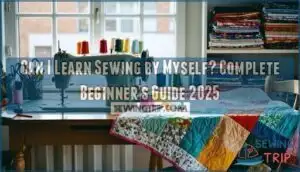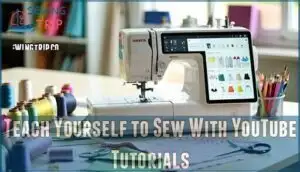This site is supported by our readers. We may earn a commission, at no cost to you, if you purchase through links.

Start with simple cotton projects to build confidence, master your machine’s basics like threading and tension, and don’t skip joining online communities. Forums like PatternReview.com connect you with 1.5 million fellow sewers who answer questions within days.
The secret isn’t avoiding mistakes but learning which resources give you the fastest path to success.
Table Of Contents
- Key Takeaways
- Teach Yourself to Sew With Books
- Teach Yourself to Sew With YouTube Tutorials
- Take Online Sewing Classes
- Utilize Sewing Patterns and a Sewing Machine
- Join Sewing Communities and Forums
- Practice and Experiment on Your Own
- Attend Local Sewing Workshops or Classes
- Learn From Sewing Blogs and Websites
- Embrace Mistakes and Learn From Experience
- Frequently Asked Questions (FAQs)
- Conclusion
Key Takeaways
- You can master sewing independently through multiple learning paths – books provide detailed foundations you can reference anytime, YouTube’s 70,000+ channels offer visual step-by-step guidance, and online classes starting at $8/month give structured lessons with community support.
- Start with simple cotton projects like pillowcases or tote bags to build confidence before tackling complex garments – these beginner-friendly materials are forgiving and help you master basic machine skills like threading and tension control.
- Join online communities like PatternReview.com with 1.5 million users who’ll answer your questions within days, share troubleshooting tips, and provide encouragement when projects don’t go as planned.
- Embrace mistakes as your best teachers – every wonky seam and ripped-out stitch builds problem-solving skills and confidence faster than perfect execution ever could, making you a more skilled and creative sewer.
Teach Yourself to Sew With Books
Learning to sew through books offers a treasure trove of knowledge at your fingertips. Smart book selection starts with beginner-friendly guides from library resources or thrift stores—they’re goldmines for self-taught sewers. These sewing books provide detailed illustrations for pattern adaptation and offer book projects you can tackle at your own pace.
Unlike rushing through online tutorials, you’ll master fundamentals through teach yourself to sew methods that stick. Self-taught sewing becomes achievable when you can flip back to clarify techniques. Learning to sew from books builds solid foundations. Many options teach basic machine maintenance.
Teach Yourself to Sew With YouTube Tutorials
YouTube tutorials offer an outstanding gateway for self-taught sewers, with over 70,000 active sewing channels providing visual learning that beats reading instructions alone. You’ll see exactly how fabric moves through your machine and how stitches should look.
Visual learning beats reading when fabric flows through your machine before your eyes
Finding Channels becomes your first skill. Look for creators with high subscriber counts and positive comments. Channels run by certified designers or experienced seamstresses offer the most reliable content. Check ratings and recent uploads to confirm you’re getting current techniques.
Tutorial Quality varies widely, so start with beginner-focused playlists that receive millions of monthly views. The best tutorials run under 15 minutes, perfect for your attention span. Look for channels offering free downloadable patterns and troubleshooting guides. Quality channels often use clear, close-up shots to demonstrate techniques.
- Beginner Projects: Start with simple tote bags or pillowcases that teach basic seams without overwhelming complexity.
- Skill Progression: Follow structured series that build from hand stitches to machine operation, then garment construction.
YouTube’s comment sections become your virtual sewing circle, where fellow learners share tips and finished projects.
Take Online Sewing Classes
Beyond traditional tutorials, online sewing classes offer structured learning paths with expert instructors and community support. Platforms like Craftsy and Skillshare provide beginner-friendly courses starting around $8 monthly. You’ll find bite-sized lessons covering everything from basic stitches to sophisticated techniques.
The project variety keeps things interesting – from simple tote bags to custom-made jackets. Interactive workshops and live Q&A sessions help troubleshoot issues. Online sewing communities within these platforms connect you with fellow learners worldwide, making your teach-yourself-to-sew journey less lonely and more successful.
For thorough learning, consider exploring top online sewing courses that cater to various skill levels.
Utilize Sewing Patterns and a Sewing Machine
Now that you’ve got your feet wet with online classes, it’s time to put rubber to the road with sewing patterns and your sewing machine. Think of patterns as your roadmap – they’ll guide every stitch while you master the fundamentals.
Pattern Mastery
Start with beginner-friendly patterns that include clear instructions and diagrams. These self-taught learning tools break down complex garments into manageable steps. To guarantee success, consider using easy sewing patterns designed for newcomers.
Machine Techniques
Practice threading, adjusting tension, and basic stitches until they become muscle memory. Your sewing machine is your best friend for consistent results.
Fabric Selection
Choose cotton or linen for first projects – they’re forgiving and easy to handle during project planning phases.
- Master straight seams first – Perfect your seam techniques on scrap fabric before tackling actual projects, focusing on consistent seam allowances and smooth stitching.
Remember, even experienced sewers started with wonky first attempts. Pattern adjustments and machine maintenance come with practice, so don’t sweat the small stuff initially.
Join Sewing Communities and Forums
Once you’ve mastered patterns and machines, connecting with fellow sewists transforms your solo journey into a shared adventure. Online support through sewing communities creates lasting bonds while accelerating your self-taught progress.
These vibrant spaces offer invaluable resources for learning to sew online:
- Skill Sharing – Experienced members share techniques that sewing tutorials might miss.
- Project Collaboration – Work alongside others on group challenges and sew-alongs.
- Feedback Exchange – Get honest critiques that help you improve faster.
- Inspiration Sources – Discover creative ideas that spark your next masterpiece.
Popular forums like PatternReview.com host over 1.5 million users keen to help beginners succeed. You’ll find answers to technical questions within 24–48 hours, plus access to exclusive discounts and professional networking opportunities. These communities become your sewing family, celebrating victories and troubleshooting disasters together. Sewing for beginners becomes less intimidating when you’re surrounded by supportive voices cheering you on. Many sewists also find inspiration and tutorials through engaging crafting blogs.
Practice and Experiment on Your Own
Starting with fabric scraps transforms your sewing journey into an adventure of discovery. You’ll master stitch variations through hands-on experimentation, building confidence with every project adaptation. Seam ripping becomes your friend—not your enemy—as you learn creative sewing techniques that tutorials can’t always teach. One can begin by learning basic sewing techniques to build a solid foundation.
| Practice Area | Beginner Focus | Intermediate Challenge | Advanced Exploration | Time Investment |
|---|---|---|---|---|
| Stitch Variations | Straight seams | French seams | Invisible hems | 30-45 minutes |
| Fabric Scraps | Cotton squares | Mixed textures | Delicate materials | 15-20 minutes |
| Project Adaptation | Simple modifications | Pattern adjustments | Design changes | 60-90 minutes |
| Creative Sewing | Color combinations | Embellishments | Mixed techniques | 45-60 minutes |
| Seam Ripping | Basic corrections | Complex fixes | Pattern redesign | 20-30 minutes |
Self-taught sewers discover their unique style through DIY sewing projects that push boundaries. Each mistake teaches more than perfect execution ever could, making you a confident creator who trusts their instincts.
Attend Local Sewing Workshops or Classes
While solo practice builds confidence, local sewing workshops or classes offer hands-on learning that’s hard to replicate at home. You’ll get real-time feedback on your technique and learn from an experienced instructor who can spot problems before they become bad habits. Plus, there’s something special about learning alongside other beginners—you’re all figuring it out together.
Here’s what makes in-person sewing classes worth your time:
- Personalized Instruction Style: Your instructor can adjust their teaching approach to match your skill level, whether you’re tackling your first seam or ready for more complex techniques like buttonholes and zippers.
The workshop benefits extend beyond just technical skills. Mastering the basic sewing techniques is essential for any beginner. Sewing lessons create networking opportunities with fellow crafters who might become your go-to fabric shopping buddies. Class curriculum usually covers fundamentals systematically, ensuring you don’t skip important basics. Most sewing classes for beginners focus on building solid foundations before moving to complex projects.
Learn From Sewing Blogs and Websites
Sewing blogs and websites offer a goldmine of free resources for anyone keen to teach yourself to sew. When selecting blogs for sewing tutorials, look for clear photos and detailed instructions that match your skill level. Popular sewing for beginners sites provide pattern hacking tips, turning basic designs into custom creations.
You’ll find inspiration sources everywhere—from project showcases featuring stunning quilts to simple tote bag tutorials. Website navigation becomes second nature as you bookmark favorite selftaught resources. Many blogs offer downloadable patterns and step-by-step guides that rival expensive courses.
The learn to sew community online shares honest reviews, helping you choose quality content over flashy marketing. Many blogs also offer tips on sewing machine maintenance to keep your equipment in top shape.
Embrace Mistakes and Learn From Experience
Every stitch gone wrong becomes your greatest teacher in sewing. When you’re learning to sew independently, mistakes aren’t roadblocks—they’re stepping stones to mastery. That wonky seam you just ripped out? It’s showing you exactly what not to do next time.
Mistakes aren’t failures—they’re your best sewing teachers in disguise
Here’s how imperfect projects fuel your growth:
- Seam ripping becomes second nature: You’ll develop creative solutions for fixing problems, turning disasters into learning opportunities through iterative sewing approaches.
- Each mistake builds confidence: Your learning curve accelerates when you stop fearing failure and start embracing the messy, beautiful process of becoming skilled.
Sewing tutorials can’t teach you everything—sometimes you need to fumble through a project to truly understand fabric behavior. Paying attention to fabric grain placement is essential for preventing distortion.
Those "failed" attempts aren’t wasted time; they’re invaluable lessons that no sewing for beginners guide can provide. When you teach yourself to sew, every mistake becomes part of your unique sewing story.
Frequently Asked Questions (FAQs)
Can You Learn to sew on your own?
You’ll master basic stitches through YouTube tutorials and practice projects. Start with simple items like pillowcases, then tackle tote bags. Modern machines guide you step-by-step, making self-teaching totally doable.
How can I teach myself to sew?
About 65% of sewing beginners start with free YouTube tutorials. Online videos beat books for visual learners.
You’ll want to grab basic supplies, practice straight stitches, and tackle simple projects like pillowcases first.
Can You Teach Yourself to sew clothes?
You can definitely teach yourself to sew clothes! Start with simple projects like straight-seam tops or elastic-waist skirts. Online tutorials, patterns, and practice will get you there.
How do you learn sewing if you’re a beginner?
Like diving into a pool, you’ll start shallow and gradually go deeper. Begin with YouTube tutorials, practice basic stitches on scrap fabric, and tackle simple projects like pillowcases before advancing to garments.
Is sewing a good skill?
You’ll find sewing incredibly useful for mending clothes, creating custom pieces, and saving money. It builds problem-solving skills, boosts creativity, and gives you independence from store-bought items.
Should you learn to sew with YouTube?
YouTube offers structured video lessons that help you master techniques visually, making it easier to catch mistakes and learn proper form than text-only instructions alone.
What are the benefits of learning to sew using books?
Books offer thorough step-by-step guidance, visual diagrams, and troubleshooting tips you can reference anytime. They’re perfect for filling knowledge gaps and providing structured learning paths that complement hands-on practice.
How can YouTube tutorials enhance the learning process for beginners?
Video tutorials absolutely transform your learning experience by showing actual hand movements, machine techniques, and troubleshooting in real-time. You’ll catch mistakes before making them and build confidence faster.
What are the benefits of joining sewing communities and forums for beginners?
Joining sewing communities connects you with experienced sewists who’ll troubleshoot your mistakes, share time-saving tips, and celebrate your victories. You’ll get tailored feedback, discover new techniques, and find encouragement when projects go sideways.
How much does learning to sew cost?
Learning to sew won’t break the bank! You’ll spend around $140 total – a basic machine costs $100, beginner supplies run $40, and free online tutorials handle the rest perfectly.
Conclusion
While professional seamstresses spend years perfecting their craft, absolute beginners can create wearable garments in just weeks. The answer to "can I learn sewing by myself" is definitively yes.
You’ve got books, YouTube channels, online classes, and supportive communities waiting to guide your journey. Start with simple projects, embrace your inevitable first-attempt disasters as learning opportunities, and remember that every expert was once a beginner who refused to quit. Your sewing machine awaits.












